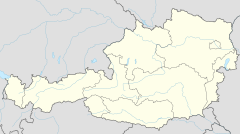St. Rupert's Church, Vienna
| St. Rupert's Church | |
|---|---|
SJ | |
| Location | |
| Location | Vienna, Austria |
| State | Vienna |
| Geographic coordinates | 48°12′43″N 16°22′28″E / 48.211944°N 16.374444°E |
| Architecture | |
| Type | Church |
| Style | Romanesque, Baroque |
| Completed | 740 |
| Specifications | |
| Direction of façade | NWbW |
| Capacity | 100 |
| Length | 27 m (88.6 ft) |
| Width | 13 m (42.7 ft) |
| Website | |
| www | |
St. Rupert's Church (
There is currently some debate whether the Ruprechtskirche is truly the oldest church in Vienna. Discoveries of old foundations under the
History
According to legend, it was founded by Cunald and Gisalrich, companions of Rupert during his occupation of the seat of bishop of Salzburg. However, because Salzburg had influence over religious issues in Vienna between 796 and 829, it is more probable that it was founded in this period.
The first reference in historical documentation is in a document of 1200 when Duke Heinrich II Jasomirgott describes a gift to the Schottenstift church. The document also mentions the Ruprechtskirche, which is labeled the oldest in the city.
After the destruction of the Roman settlement, the core part of the city grew in the area near the church. It was the seat of the religious administration before that function was transferred to the
During the Middle Ages, the church was the seat of the Salt Office (Salzamt), which distributed salt to individual buyers and ensured its quality. The church overlooks the jetty of the salt merchants on the Danube channel.
The ivy-covered church has been rebuilt and altered many times in its history. In 1276, it was damaged by fire and modified. The choir dates from the 13th century, while the southern nave dates from the 15th century. In 1622, it was redecorated in Baroque style. It was also somewhat damaged by shellfire during World War II and affected by the demolition of the nearby ruins of another building. In the middle of the apse, there are two Romanesque stained-glass windows.
Other features
The oldest bells in Vienna are located in the church, dating from around 1280.
The oldest glass window panes (dating from approximately 1370) can be found in the church. They depict a crucified Christ and the Madonna with baby.
A statue of Saint Rupert is located in the north part of the main tower.
The arch on the western gallery has a plaque with the label “AEIOU 1439”, an undecyphered motto of Emperor Frederick III. The plaque was designed to commemorate the entrance of the emperor to Vienna on December 6, 1439. According to tradition, AEIOU stands for (in Latin) "AUSTRIAE EST IMPERARE ORBI UNIVERSO" or in German "ALLES ERDREICH IST OESTERREICH UNTERTAN", both meaning "The whole world is subject to Austria"
A relic of the sarcophagus of
Gallery
-
St Rupert's
-
Interior
-
Altar
-
Interior
-
Stained glass window
-
Stained glass window
-
Stained glass window
-
Statue of St. Rupert
-
The Ruprecht staircase connects the Morzinplatz with the Ruprechtsplatz
-
The little squares and lanes surrounding the Ruprechtskirche belong to the oldest part of Vienna
-
Remembrance of the victims of the Gestapo
References
- Citations
- ^ Brook 2012, p. 81.
- Bibliography
- Brook, Stephan (2012). DK Eyewitness Travel Guide: Vienna. London: Dorling Kindersley Ltd. ISBN 978-0756684280.
- Gaillemin, Jean-Louis (1994). Knopf Guides: Vienna. New York: Alfred A. Knopf. ISBN 978-0679750680.
- Schnorr, Lina (2012). Imperial Vienna. Vienna: HB Medienvertrieb GesmbH. ISBN 978-3950239690.
- Schulte-Peevers, Andrea (2007). Alison Coupe (ed.). Michelin Green Guide Austria. London: Michelin Travel & Lifestyle. ISBN 978-2067123250.
- Unterreiner, Katrin; Gredler, Willfried (2009). The Hofburg. Vienna: Pichler Verlag. ISBN 978-3854314912.
- Wehdorn, Manfred (2003). Vienna. a Guide to the Unesco World Heritage Sites. Berlin: Springer. pp. 105–106. ISBN 978-3-211-40863-6.













